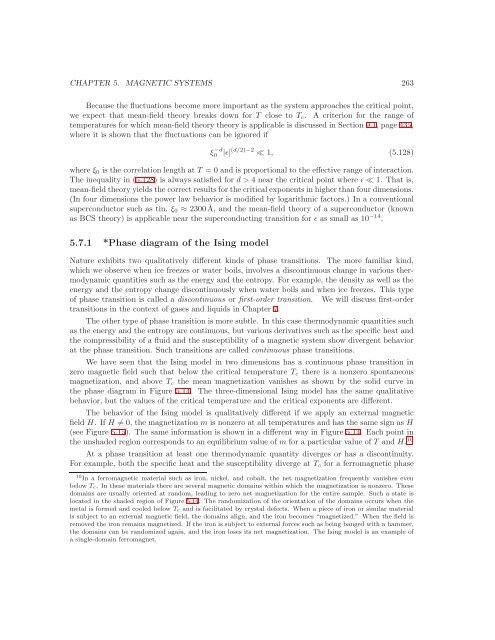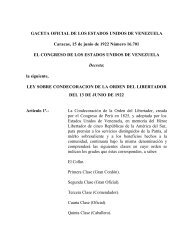Chapter 5 - WebRing
Chapter 5 - WebRing
Chapter 5 - WebRing
Create successful ePaper yourself
Turn your PDF publications into a flip-book with our unique Google optimized e-Paper software.
CHAPTER 5. MAGNETIC SYSTEMS 263<br />
Because the fluctuations become more important as the system approaches the critical point,<br />
we expect that mean-field theory breaks down for T close to Tc. A criterion for the range of<br />
temperatures for which mean-field theory theory is applicable is discussed in Section 9.1, page 435,<br />
where it is shown that the fluctuations can be ignored if<br />
ξ −d<br />
0 |ǫ|(d/2)−2 ≪ 1, (5.128)<br />
where ξ0 is the correlation length at T = 0 and is proportional to the effective range of interaction.<br />
The inequality in (5.128) is always satisfied for d > 4 near the critical point where ǫ ≪ 1. That is,<br />
mean-fieldtheoryyieldsthecorrectresultsforthecriticalexponentsinhigherthanfourdimensions.<br />
(In four dimensions the power law behavior is modified by logarithmic factors.) In a conventional<br />
superconductor such as tin, ξ0 ≈ 2300˚A, and the mean-field theory of a superconductor (known<br />
as BCS theory) is applicable near the superconducting transition for ǫ as small as 10 −14 .<br />
5.7.1 *Phase diagram of the Ising model<br />
Nature exhibits two qualitatively different kinds of phase transitions. The more familiar kind,<br />
which we observe when ice freezes or water boils, involves a discontinuous change in various thermodynamic<br />
quantities such as the energy and the entropy. For example, the density as well as the<br />
energy and the entropy change discontinuously when water boils and when ice freezes. This type<br />
of phase transition is called a discontinuous or first-order transition. We will discuss first-order<br />
transitions in the context of gases and liquids in <strong>Chapter</strong> 7.<br />
The other type of phase transition is more subtle. In this case thermodynamic quantities such<br />
as the energy and the entropy are continuous, but various derivatives such as the specific heat and<br />
the compressibility of a fluid and the susceptibility of a magnetic system show divergent behavior<br />
at the phase transition. Such transitions are called continuous phase transitions.<br />
We have seen that the Ising model in two dimensions has a continuous phase transition in<br />
zero magnetic field such that below the critical temperature Tc there is a nonzero spontaneous<br />
magnetization, and above Tc the mean magnetization vanishes as shown by the solid curve in<br />
the phase diagram in Figure 5.14. The three-dimensional Ising model has the same qualitative<br />
behavior, but the values of the critical temperature and the critical exponents are different.<br />
The behavior of the Ising model is qualitatively different if we apply an external magnetic<br />
field H. If H = 0, the magnetization m is nonzero at all temperatures and has the same sign as H<br />
(see Figure 5.15). The same information is shown in a different way in Figure 5.14. Each point in<br />
the unshaded region corresponds to an equilibrium value of m for a particular value of T and H. 10<br />
At a phase transition at least one thermodynamic quantity diverges or has a discontinuity.<br />
For example, both the specific heat and the susceptibility diverge at Tc for a ferromagnetic phase<br />
10 In a ferromagnetic material such as iron, nickel, and cobalt, the net magnetization frequently vanishes even<br />
below Tc. In these materials there are several magnetic domains within which the magnetization is nonzero. These<br />
domains are usually oriented at random, leading to zero net magnetization for the entire sample. Such a state is<br />
located in the shaded region of Figure 5.14. The randomization of the orientation of the domains occurs when the<br />
metal is formed and cooled below Tc and is facilitated by crystal defects. When a piece of iron or similar material<br />
is subject to an external magnetic field, the domains align, and the iron becomes “magnetized.” When the field is<br />
removed the iron remains magnetized. If the iron is subject to external forces such as being banged with a hammer,<br />
the domains can be randomized again, and the iron loses its net magnetization. The Ising model is an example of<br />
a single-domain ferromagnet.

















